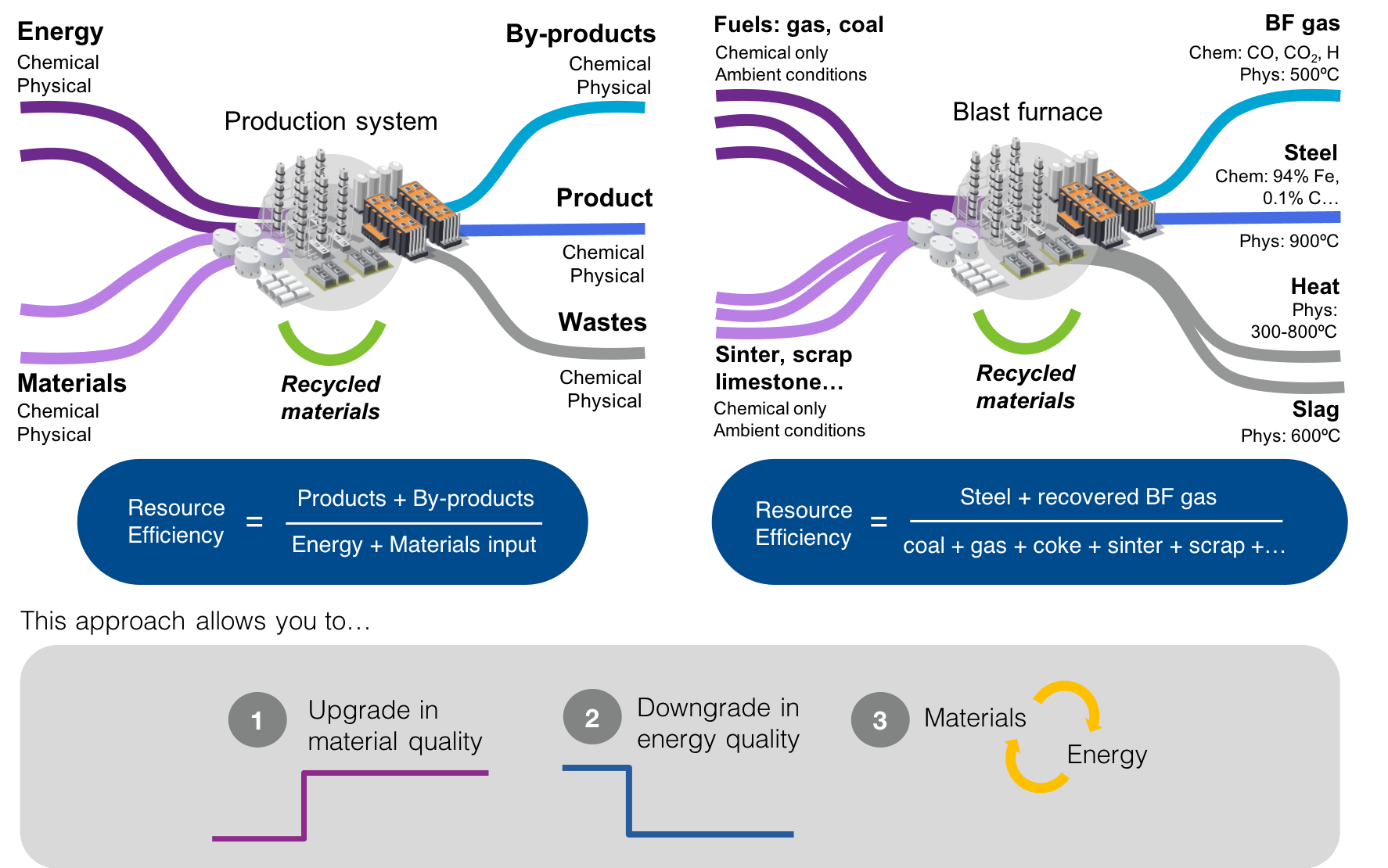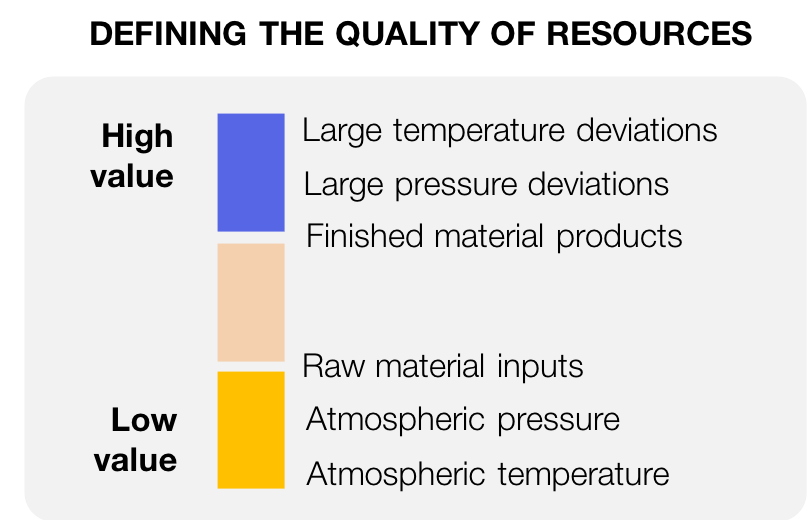In my previous post, I introduced the concept of resource efficiency: the integrated efficiency with which energy and materials are transformed in industrial processes. I mentioned that improvements in resource efficiency are considered indispensable to achieving globally agreed CO2 emission and energy reduction targets. This is because trends in production volumes are predicted to keep rising to meet growing population demands, and opportunities for improving energy efficiency are beginning to reach technical limits.
Energy-intensive material producers have compelling reasons to take resource efficiency seriously. Altogether, the production of metals, chemicals, plastics, paper and cement generate over 60% of total industrial CO2 emissions. Improving resource efficiency promises to be the most cost-effective option to simultaneously avoid wasting scarce and toxic resources, reduce operating costs and CO2 emissions, and improve responsiveness to future climate and environmental regulations. In fact, understanding the current state of a facility’s resource use, the factors driving it and the opportunities available to minimise it, will be a prerequisite to staying competitive in the future.
Quantity matters: the need for a bulletproof metric
Measurement is the dogma of industrial production. Understanding a company’s reliability, safety, or its production quality necessitates tracking their performance metrics. Resource efficiency is no different. The first step in becoming more resource efficient involves putting a number on it. In fact, plant managers are under increasing pressure from top-level decision makers, who are urging them to quantify their resource efficiency. In most cases though, material producers struggle to come up with a metric that is meaningful.
And this comes as no surprise. Industrial production involves myriad processes, which combined constitute a complex network of interacting resources, including energy, raw materials and water. This complexity requires trade-offs: reducing the energy use in one part of the production process may increase material use elsewhere and vice versa. The difficulty in accurately capturing these interactions lies in the fact that companies currently measure energy and material efficiency using separate indicators, providing in the process only partial insight into the potential of resource efficiency.
So, how can a company go about adequately measuring its integrated resource efficiency? Emerson has committed four years of research funding to offer producers a competent answer. Together with the University of Cambridge in the UK, Emerson developed an engineering solution based on established thermodynamic methods. Though devised in the 1900s, these methods experienced a renaissance in the past two decades; they required the right combination of vision, ambition and business case to become a reality.
The proposed approach traces resource use across entire systems and characterises resources as a combination of two components: a chemical portion, which is based on the resource’s composition and concentration; and a physical portion, which accounts for the resource’s temperature and pressure. Based on this, resource efficiency is expressed as a ratio of useful resource outputs to resource inputs (see Figure 1). Results from these methods are founded on accurate energy (fuel inputs, energy by-products and heat losses) and material flow data (raw material inputs, material products, by-products and waste), and are substantiated through rigorous data collection, cleaning and analysis processes.
Unlike conventional energy-intensity or material-efficiency metrics, this new indicator integrates energy and material flows into a single, dimensionless measure; it compares energy efficiency and material efficiency on an equal footing. In doing so, it consolidates multiple key performance indicators that currently measure resource use from different standpoints, including: yield rates, fuel and raw material consumption, heat-recovery rates, the recovery of material by-products and the generated waste. As a result, producers are empowered to make the right choices at the right time, while also widening the breadth of efficiency options available and capturing unavoidable trade-offs.
Quality matters: beyond quantity
A fundamental feature of this novel, integrated resource efficiency approach is its ability to appraise resources. In Emerson, we understand that not all resources are equally valuable, which is why we measure the quality as well as the quantity of resources. We do this by using thermodynamics. That is, we rate the mass and energy flows in production systems according to their chemical and physical contents (as mentioned above).
The greater the temperature, pressure and composition of a resource deviates from environmental conditions, the greater its value (see Figure 2). For example, a hot, highly pressurised steam flow is more valuable than one whose temperature and pressure are close to atmospheric. Equally, pure, more refined material compositions are of greater value than those readily available in nature, i.e. the difference between steel and iron ore. Appraising resources using thermodynamics therefore helps us judge what streams are worth focusing on.

Figure 1 – This figure depicts how energy and material flows are incorporated into a single resource efficiency metric. The process of a steel blast furnace is used as an example to depict how the resource efficiency metric would be calculated in practice. Energy and material flow data alongside data on composition, temperature and pressure is required to quantify the chemical and physical content of all resource flows. Valuing resources using thermodynamics allows us to capture interactions between energy and material flows, as well as the quality of resources and the quality upgrades and downgrades taking place during the transformation of materials. “Chemical” and “physical” reflect the components of the resources that were considered. Raw materials and fuels are often at room temperature and pressure, so their physical value is negligible.
But capturing the quality of resources is not just about measuring the thermodynamic value of individual streams. It also involves calculating the quality changes and interactions that occur throughout production chains. In industry, these quality changes often take the form of material upgrades at the expense of energy downgrades, i.e. fuels are consumed and converted into heat to upgrade low-quality raw materials into valuable finished products.
Achieving top-quartile performance

Figure 2- Our method values the quality of energy and materials, based on a physical, thermodynamic understanding of resources.
Emerson is aware that manufacturers are already overwhelmed with the sheer volume of performance indicators available. For many, the portfolio of indicators collected is so large that extracting valuable information from them becomes increasingly taxing. This is precisely why Emerson is prepared to offer a new key performance indicator. We believe it provides more for less: it simplifies current performance-tracking practices while adding unparalleled value. Our integrated resource efficiency metric combines multiple resource indicators into a single measure, and does so by combining energy and material flows, thereby revealing potential interactions between them.
In my next post I will show how this new metric was applied to measure and benchmark the resource efficiency of the global steel sector.
From Jim: For more on ways to improve resource efficiency, visit the Top Quartile Operational Certainty section on Emerson.com or connect and interact with our industry experts at the October 1-5 Emerson Exchange conference in San Antonio, Texas.





